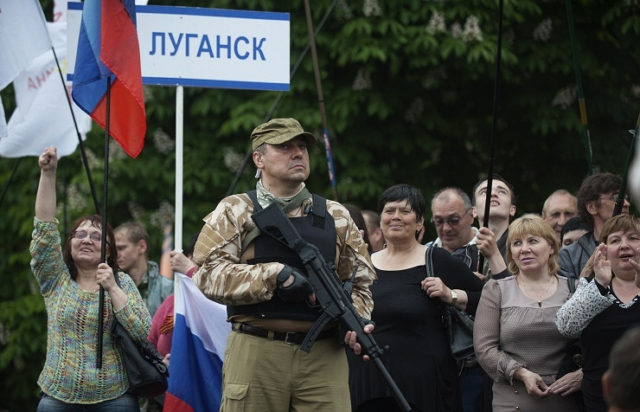
DPR and LPR Increasingly at Odds, Complicating Moscow’s Approach to Ukraine
Publication: Eurasia Daily Monitor Volume: 18 Issue: 81
By:

Most commentators in Russia, Ukraine and the West tend to treat the Moscow-backed breakaway Donetsk People’s Republic and Luhansk People’s Republic (DPR, LPR), which together control about 3.3 million people in eastern Ukraine, as a single whole. But in reality, Russian analyst Yury Kovalchuk argues, conflicts between the two entities have continued to grow worse. That discord is now supposedly so acute that it is complicating both the Russian Federation’s short-term goal of winning support in Ukraine for Moscow’s position on the DPR and LPR as well as the Kremlin’s long-term goal of reintegrating these regions into Ukraine in order to ensure Moscow has significant leverage over Kyiv. Indeed, the spectacle of the conflicts between the two is alienating even ethnic Russians in Ukraine and providing more justification for Ukrainians who insist that the two regions must be reintegrated into Ukraine as regular oblasts like all others in that country.
In an important new article, “The Split Between Donetsk and Luhansk—What is Preventing the Republics from Living Together?” Kovalchuk says that efforts to paper over these divisions have not worked and may now be backfiring. Indeed, he suggests, the fact that such an effort had to be made at all only underscores how deep the divisions between the two have become and how serious a problem this is for policymakers in Moscow (Ritmeurasia.org, May 14).
On April 22–23, delegates from the DPR, LPR and the Russian Federation assembled in Donetsk for a forum entitled “The Unity of Russians: The Defense of Their Rights and Freedoms” (Riafan, May 5; Literaturnaya Gazeta, April 29; Evrazia, Narodnyye Novosti, April 27). That was a worthy goal, Kovalchuk contends; but it was not achieved. For the first time ever, the head of the LPR did not show up at such a session in the DPR; and no progress was made in overcoming differences between the two “republics.” Some pro-Russian commentators ignored or at least played down that outcome (Ritmeurasia.org, April 30), but their words did little to conceal the reality.
Those who attended or paid attention to this meeting could see just how false the bravado claims of the organizers were, Kovalchuk continues. Already for more than a year, the border between the two has been closed, forcing residents and others who want to travel between the DPR and the LPR to go via Russia’s Rostov Oblast, a detour that dramatically increases both the length of the journey and the cost. Ostensibly, the closure of the DPR-LPR border is all about fighting the pandemic; but clearly more is going on, he argues. The two entities have long had different border policies with regard to Ukraine and to the Russian Federation. The LPR is “quite liberal” in that regard, allowing more or less free passage, while the DPR is far stricter and imposes more controls on movement both to Kyiv-controlled Ukrainian areas and to the Russian Federation. In fact, Kovalchuk notes, figures show that more people pass through the LPR-Ukraine “border” in a day than cross the DPR-Ukraine one in a week (Ritmeurasia.org, May 14).
In fact, according to the Russian journalist, “the very existence of any border between the DPR and LPR seems nonsensical.” It originally took shape in 2015, when the two “republics” erected checkpoints on their administrative boundaries, supposedly to control the flow of contraband and pro-Ukrainian militants. When that DPR-LPR border was created, it was presented as a temporary measure that was supposed to remain in place only until 2018. But there has been no progress toward eliminating it over the last three years; and if anything, it has become more formalized and frozen in place than ever before.
This has serious consequences for Moscow, Kovalchuk insists. “If tomorrow a decision were made about integrating the DPR and LPR into a single whole, this would not be so simple.” Their local laws differ not only when it comes to the border but about a wide variety of things. And that means any broader accord with Kyiv leading to their reintegration would be even more difficult because the legal disparities between the DPR and LPR would have to be eliminated before the two could be reincorporated and become the unified pro-Russian entity within Ukraine that Moscow has been promoting.
To be sure, the commentator says, the most important industrial, transportation and communication links of the two remain under common control. “Even the railroads of the DPR and LPR are a single enterprise” and are thus beyond these divisions, at least for now. But in many other spheres, he warns, DPR and LPR lawmakers are introducing measures that threaten the Donbas as “a single economic system, closely connected not only by economic and cultural ties” but by other links as well. According to Kovalchuk, all of this is the work of local elites who suffer from “banal ambitions” of increasing their own power and status regardless of how that fits in with the interests of Moscow or anyone else. Lying behind these “banalities,” he posits, are the desire of these officials either to become separate and independent “countries” like Abkhazia and South Ossetia or to enter Russia as separate oblasts so that all the positions of those now in power will be maintained.
The fractiousness of the DPR and LPR is having a more immediate impact in Ukraine, Kovalchuk concludes, by highlighting the inability of Russian officials to put their own house in order. This further alienates those in Ukraine and ethnic Russians there in the first instance from thinking they will benefit if the current situation is extended. Instead, what the Russians in the DPR and the LPR are doing only generates more support inside Ukraine and internationally for Kyiv’s plans to reintegrate the two entities on its own terms rather than in deference to any prerequisites set in Moscow, Donetsk or Luhansk.



